
All improvements to property are required to be submitted to the Architectural Review Committee for Raleigh Creek (ARC) for Review And Approval prior to the inception of any construction.
Further, it is the applicant's responsibility to ensure compliance with the latest revisions to these guidelines.
Copies will be made available upon request to the ARC.
What you see here is a searchable version. If there are any differences between the official document and this searchable version, the official document will take precedence.
Raleigh Creek is a residential development of L.S. Development LLC. Raleigh Creek encompasses approximately 142.77 acres of land and is located in Harris County, Texas.
Intent of Guidelines
The objective of these Builder Guidelines is to achieve quality and uniformity in building construction and to address certain items and areas which are common to residential construction and which the Raleigh Creek Homeowner Association Inc. will exert strict control.
These Builder Guidelines are supplemental to the Declaration of Covenants, Conditions and Restrictions for Raleigh Creek (CCRs) and are to be used in the architectural review of Builder plans. Non-compliance with these guidelines shall be grounds for disapproval of plans.
Builders within Raleigh Creek are responsible for compliance with all applicable city, county, state and federal regulations.
The Builder Guidelines are intended for the use of the various Builders in Raleigh Creek and the design professionals they employ. They are aimed at providing an attractive, coordinated physical environment both during and after construction. Design diversity is encouraged in order to create a pleasing street scene and to provide a separation of product line. However, certain standards have been adopted for key elements to provide continuity throughout the project.
The Builder Guidelines contain the construction and development standards adopted by the Architectural Review Committee for Raleigh Creek and are subject to change without notice. However, lots or tracts purchased prior to any changes shall be grandfathered and not subject to the revisions unless agreed to in writing by L.S. Development LLC as the developer for Raleigh Creek and the Builder. These guidelines do not necessarily represent all of the restrictions which may be imposed on a specific lot or parcel of land. Failure to submit the required applications to the ARC for review shall be construed as a violation of the Raleigh Creek Builder Guidelines.
Prior to commencing design of a project, the property deed, the recorded subdivision plat and the CCRs should be referred to. In addition, Raleigh Creek is located within the City of Tomball and is subject to Tomball's development ordinance and any other ordinance which Tomball may, by law, extend outside its corporate limits. The City of Tomball should be contacted prior to initial development to ensure compliance with all applicable regulations.
Raleigh Creek is located in Harris County, Texas, and must adhere to any and all development regulations, including road paving and construction standards. In addition, Harris County should be contacted regarding plan approval and permit procedures.
The Builder shall develop and maintain individual lots in a manner prescribed by the CCRs, recorded plats/replats, rules and regulations of the Raleigh Creek Homeowners Association, Inc. and by these Builder Guidelines and standards. Compliance with building setback lines, lot layouts, driveways, sidewalks, garages, wiring requirements, etc. are the responsibility of the Builder.
These Builder Guidelines ("Guidelines") outline design goals, design criteria and the design review process for new home construction in Raleigh Creek by LS Development, LLC (hereinafter "Developer" and "Declarant").
It is anticipated that each Builder shall enter into a Builder's Lot Purchase Agreement (the "Sales Contract") with Developer. For previously purchased lots without improvements, these Guidelines and the Declaration of Covenants Conditions and Restrictions will apply.
All new home construction be must reviewed and approved by the Architectural Review Committee (the "ARC") appointed by Declarant prior to commencement of any building or construction activity. This approval can be secured in a timely fashion if applicable criteria specified in Sections II, Ill and V of this guide are met to the satisfaction of the ARC.
New home construction must conform to these Guidelines, to the Declaration of Covenants Conditions and Restrictions (the "Declaration"), to Sales Contract provisions; and to state and local building codes, zoning ordinances, or other governmental regulations (collectively "the Applicable Codes"). If provisions of these Guidelines are more restrictive than the Declaration, the Sales Contract or the Applicable Codes, the provisions of these Guidelines apply. If these Guidelines conflict with the Declaration, Sales Contract, or Applicable Codes; the provisions of the Declaration, Sales Contract or Applicable Codes apply. These Guidelines may be amended by addition, deletion, or re-issuance at any time by Declarant without consent of the Members.
Subsequent construction, exterior remodeling and/or expansion, and items not covered in these Builder Guidelines will be reviewed and approved by the ARC.
The design for each home must be approved in writing by the ARC before construction of the home may begin. Any deviation from approved plans during construction, without the ARC's written approval, constitutes a violation. Corrections of such deviations may be required. Notice of approval shall be in the form of a letter from the ARC to the party submitting the plans. Copies of approved plans and approval letters will be kept on file by the ARC until completion of the development section. The ARC will review submissions and make every effort to give notice of approval or disapproval within five (5) working days following receipt and review of submissions.
The ARC meets as necessary to review design submittals. The Developer's Residential ARC Administrator will screen all submittals before calling a meeting of the ARC. The ARC will only review completed submittals. All drawings must be accurate enough to be scaled reliably. Faxed materials will be accepted for preliminary home design and plot plan approvals. Any variances, however, must be requested and granted in writing. Faxes will not be accepted in place of normal submission procedures. Submittals shall be sent to:Only complete submittals will be reviewed. All drawings shall be drawn to scale. Faxed materials will be accepted for preliminary home design (approval of master set of plans) and plot plan change approvals only. Variances/Deviations must be requested in writing.
The ARC requires one set of the following for production home plan submittals
It is the Builder's responsibility to assure that foundation plans are designed by a licensed professional engineer experienced in residential home construction.
Upon approval of a production home floor plan and series of elevations, only site/plot plan approvals are required for each home.
Each Site/Plot Plan must be approved in writing before construction of the residence can begin. Submittal must depict:
These Guidelines are intended to describe a general level of conformance for development. The Guidelines and the procedures set forth herein may be modified or waived from time to time by the ARC and do not supersede compliance with applicable federal, state, county, or local laws and regulations.
These Guidelines set forth the requirements, procedures, and technical criteria used by the ARC for the review of site development plans and exterior building designs. Approval by the ARC does not constitute approval of or satisfaction of any governmental agency requirements. Compliance with these guidelines does not provide exemption from required state, county or local approval procedures.
All structures must conform to any state or local building codes, zoning ordinances, or other governmental regulations. If any provisions of these Guidelines are more restrictive than other applicable codes, the provisions of these Guidelines apply.
Neither the Declarant, Developer, ARC, nor their individual members, partners, employees, agents, or the successors or assigns of any of them shall be liable in damages to anyone submitting to them for approval of any plans and specifications or request for variances from the Guidelines, or to any owner or occupant of any parcel of land affected by the Guidelines, or to any third party, and the submission of plans or requests constitutes an express waiver and release of these third parties to the fullest extent permitted by law.
Site plans must conform to restrictions set forth in the Declaration; the recorded subdivision plat which shows building setback lines; easements dedicated by separate instruments; and all applicable government ordinances. In some cases, different setbacks may be enforced by deed restrictions, neighborhood architectural guidelines, and/or the ARC for aesthetic reasons. Developer reserves the right to modify setback requirements.
Typical building guidelines and easements are depicted in accordance with the recorded plat. In addition to these requirements, other setbacks are enforced by deed restrictions for aesthetic reasons.
Front yard building setback lines will be in accordance with the recorded plat.
The side yard building setbacks are 5 feet (5') on each side. Corner lot building lines are fifteen feet (15') from the side street property line unless otherwise shown on the recorded plat.
The rear yard building setback is fifteen feet (15'), or the width of the utility easement, whichever is greater. No building shall be located nearer than fifteen feet (15'), or the width of the utility easement from the rear property line. Encroachment by residential structures and garages is prohibited in utility easements. All setbacks shall be measured to the edge of building walls and not to the edge of the respective overhangs.
Front and side setbacks of lot varying sizes shall be determined on an as-needed basis and incorporated into these Guidelines by addendum.
Prior to placement of any forms, builder should review the most recently recorded plat and any recorded encumbrances for the specific lot to verify all setback requirements.
Total site coverage of building, may not exceed 45% for two-story homes and 55% for one-story homes. These percentages are approximations and apply to all areas within the property lines. Lot coverage does not include flatwork such as patio, driveways, sidewalks, walkways, swimming pools, pool decks and spas are not considered in the calculation for lot coverage for the purposes of these Builder Guidelines.
The open space on a lot must be left natural if in a wooded area. Regardless of whether a lot is located in a wooded area or plains area, the landscape criteria in Section II, Paragraphs H. and I. of these Guidelines must be met.
The following table represents the minimum square footages for each product line in Raleigh Creek.
75-Foot Lot: Minimum:
One Story 2,400
Two Story 2,500
Lots siding on standard interior street corners shall have a fifteen foot (15') side street building setback (unless otherwise shown on the recorded plat), a fifteen foot (15') front building setback (unless otherwise shown on the recorded plat), and a five foot (5') building line on the interior lot side.
The rear yard building setback is ten feet (10'), or the width of the utility easement, whichever is greater. No building shall be located nearer than ten feet (10'), or the width of the utility easement from the rear property line. Encroachment by residential structures and garages is prohibited in utility easements. All setbacks shall be measured to the edge of building walls and not to the edge of the respective overhangs.
Garages and driveways on corner lots shall be located adjacent to the interior property line not the property line adjacent to the side street. "Side out" garages to a side street are prohibited.
An area of open space is required at all corner lots where intersections occur. These intersections shall be unobstructed to permit pedestrian and vehicular view when near an intersection. No trees or other potentially opaque landscaping is permitted in this area. This shall be twenty-five feet (25') in distance from each street at the corner [Figure 1].
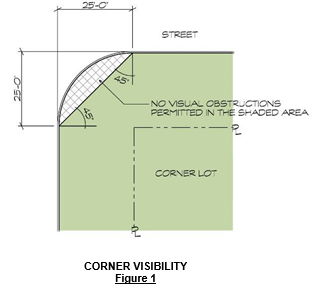
Sidewalks are to be constructed by Builders within street rights of way (R.O.W.) frontage to all front or side property lines adjoining street R.O.W. The sidewalks shall be four feet (4') in width and shall be located four feet (4') from back of curb [Figure 2]. Sidewalks shall be located three feet (3') from back of curb on all cul—de-sacs [Figure 3].



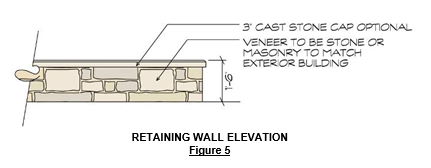
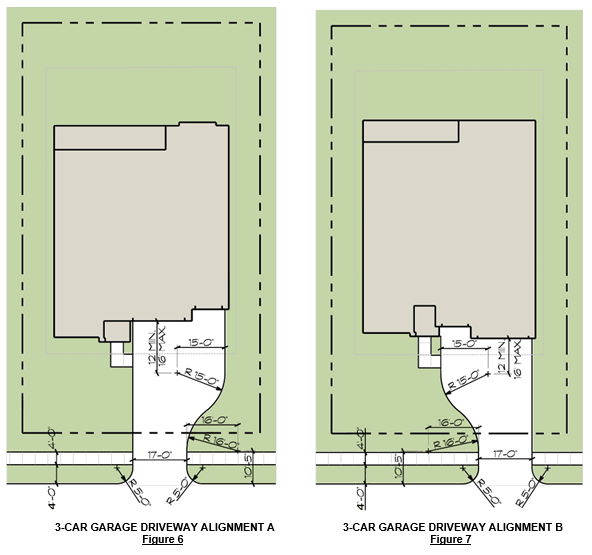
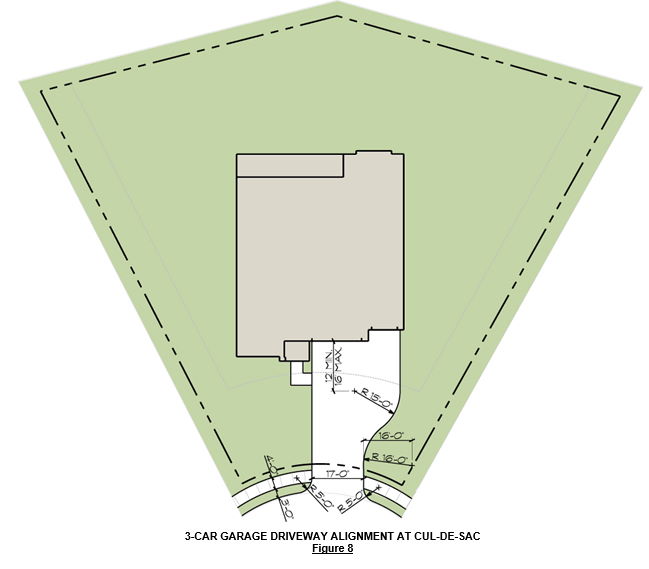
All wood fences are to be constructed with quality, new wood, consisting of treated pine posts and stringers, with posts on eight foot (8') centers and a minimum of three stringers. All other material shall be No. 2 grade cedar.
• Standard Fence — Standard Fence shall have three (3) stringers miniumum. The top stringer shall be sixteen feet (16') to prevent sagging. Pickets to be No. 2 grade one inch (1") by six inch (6") cedar. No other materials are acceptable. [Figure 9]
• Corner Lots - Capped wood fences will be required on corner lots. Capped wood fences shall have three (3) stringers, with a two inch (2") by six inch (6") cap, one inch (1") by six inch (6") fascia and one inch (1") by two inch (2") trim affixed to the top stringer. [Figure 10] See landscape guidelines for required ligustrum hedge along corner lot side fence.
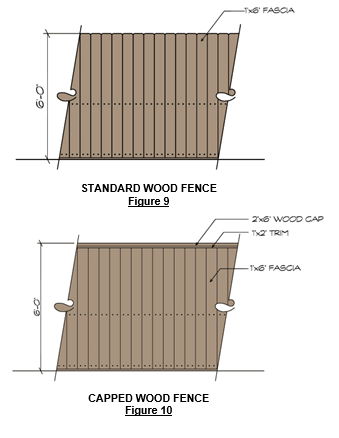
• Interior Lots:
Fence must be set back at least fifteen feet (15') from the front of the home, but no further back than the mid-point of the home. The intent of the construction is to screen the air conditioning units, but still provide access to public utility meters and services. The finished side of a fence should always face the public view. A "good neighbor" fence policy is required for all privately viewed conditions. Alternating sections are to occur at regular fence post intervals only, so that an entire panel is dedicated to one lot and the following panel is dedicated to the adjacent lot and so forth. In this manner, both lots receive approximately the same exposure to finished sides of a picket fence structure.
• Corner Lots:
Fence must be located halfway between the property line and the building line. For example, if a corner lot building line is fifteen feet (15'), the fence must be located seven and one-half feet (7.5') within the property, not on the property line.
The fence perpendicular to the side street (parallel to the front street) may be set back as necessary to provide for access to public utility meters, but must be far enough forward to screen the air conditioning units. The finished, or "picket" side of the fence must face the side street and the fence shall be capped. However, in no case may the fence be closer than five (5') feet behind the front of the home, and further back than the mid-point of the home.
The finished side of a fence should always face the exterior or public side. Any exposures to public roads, greenbelts, ditches, or detention basins will be considered public view. In situations where good neighbor (interior to lots) fence is required and can be seen from public it is understood that the fence shall remain good neighbor.
Where residential lots are located adjacent to either a commercial, institutional, or other more public use, the finished side of a fence should always face the non-residential use.
Where six (6') foot wood good neighbor or side fence meets five (5') foot ornamental iron back of lot fence (Greenbelt and Lake Lot Conditions) there shall be a sixteen foot (16') transition from wood to ornamental iron [Figure 12].
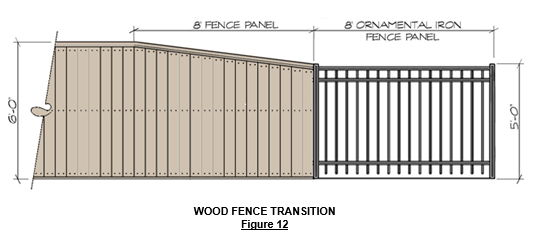
Ornamental steel fencing shall be required on all front fencing and on the rear property line of lots adjacent to water bodies, amenity lakes and greenbelts, and all gates must face the street.
Fence shall be Ameristar® Montage ATF"' Welded Ornamental Steel MajesticTh' 3R EXT 5'T 8W, Black (or another suitable type approved by the ARC). It shall be installed in accordance with manufacturer's specifications for fence series. Pedestrian gates are allowed, but not required on all lake and greenbelt lots. The gates shall not exceed forty inches (40") in width, inclusive of gate hardware.
Fence is three (3) rails and the height of fence shall be five feet (5') measured from natural grade.
System shall be installed by contractor thoroughly familiar with the type of construction involved, materials and techniques specified.
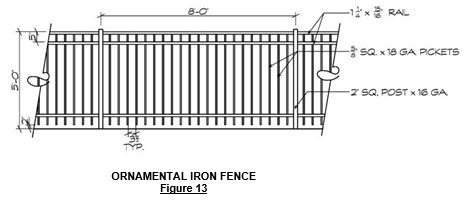
• All sections within Raleigh Creek shall be required to follow the Street Tree program.
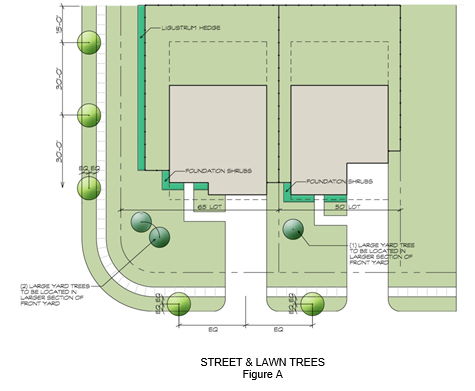
• The purpose of Street Trees is to present a formal row of trees parallel to the curb along all street rights of way. The following sets forth the minimum number of street trees required for each typical interior lot. Corner lots will have a greater number of required street trees and cul-de-sac lots will not have Street Trees. [Figure A]
| Street Trees | |
| Required Quantity | Described above |
| Species: | Live Oak |
| Size: | 45 Gallon - minimum 2 3/4" caliper |
| Height: | Minimum 8'-10' |
| Spread: | Minimum 4'-5' |
• Street Trees are to be planted halfway between the curb and sidewalk.
One (1) Street Tree is required for each interior lot, centered between the driveway and the property line on the main part of the yard. The Street Tree shall be located halfway between the back of curb and the sidewalk [Figure A]
• Four (4) Street Trees are required for each corner lot, with one (1) at the front of the home and three (3) along the side street between the curb and sidewalk [Figure A].
• No street trees shall be required for cul-de-sac lots.
Yard Trees
• In addition to the street trees, yard trees will be required for each home. Placement of trees on Standard Interior Lots and Corner Lots are illustrated on Figure A. Corner Lots have different criteria for different lot widths. See below.
| Yard Trees | |
| Required Quantity | Described above |
| Species: | Burr Oak, Live Oak, Nuttall Oak, Shumard Oak, Red Oak, Water Oak, Mexican Sycamore, Bald Cypress, Holly, Loblolly Pine, Japanese Blueberry, Magnolia or other trees approved by ARC. |
| Size: | 65 Gallon - minimum 3" caliper |
| Height: | Minimum 10'-12' |
| Spread: | Minimum 5'-6' |
Two (2) yard trees are required.
• Four (4) yard trees are required.
• For all cul-de-sac lots, two (2) yard trees are required.
Other Vegetation [Figure B]
• In addition to the tree requirements above, individual lots must meet the following minimum requirements.
• Minimum fifteen (15) Evergreen Shrubs - Type and Size outlined below. Evergreen shrubs are to be located in the back one-third of the yard, closest to the home.
• Minimum Twelve (12) Flowering Shrubs — Type and Size outlined below. Flowering shrubs to be located as accents to Evergreen shrubs.
• Minimum Two (2) Ornamental TreeNertical Accent Type and Size outlined below. Preferred location of OrnamentalNertical Accent trees is within the landscape bed. 0'1 Ornamental tree does not count as a yard tree.
• Minimum Twenty (20) Small Ground Cover — Type and Size outlined below.
• A continuous ligustrum hedge is required on corner lots along the entire length of the side fence. The hedge shall be a minimum of five (5) gallon ligustrum, thirty inches (30") on center.
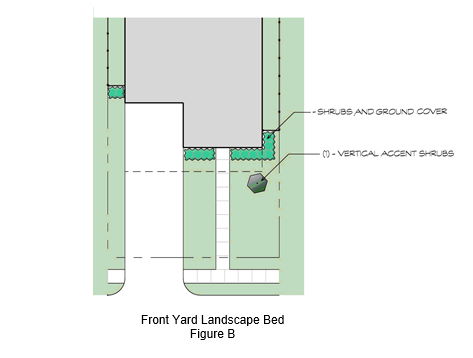
• The scrubs and ground cover are in addition to the foundation shrubs required; and are as follows:
APPROVED PLANT LIST FOR ACCENT TREES & PLANTING ISLANDS
| TYPE A | TYPE C | TYPE D | TYPE E | TYPE F | Type G |
| Accent Trees | Shrubs | Groundcovers | Vines | Grasses | Perennials/ Annuals |
| 30 gal. | 5 gal. | 1 & 2 gal. | Crossvine | Common Bermuda | Frikarti Aster |
| Bald Cypress | Butterfly Bush | Asian Jasmine | Sweet Autumn Clematis | Hybrid Bermuda | Shasta Daisy |
| Trumpet Creeper | Tall Fescue Ky-31 | Coreopsis | |||
| Burr Oak | Esperanza | Bulbine | Lavender Trumpet Vine | Annual Rye Grass | Holly Fern |
| Live Oak | Gulf Coast Muhly | Hamelin Grass | Climbing Fig Vine | St. Augustine Grass | Fern |
| Carolina Jessamine | Gerbera Daisy | ||||
| Mexican Sycamore | Indian Hawthorne | Iris spp. | Purple Japanese Honeysuckle | Basketflower | |
| Nuttall Oak | Knock Out Rose | Lantana spp. | Hall's Honeysuckle | Daylily | |
| Shumard Oak | Mexican Bush Sage | Mexican Feather Grass | Trumpet Honeysuckle | Louisiana Iris | |
| Evergreen Wisteria | Society Garlic | ||||
| Water Oak | Miscanthus Grass | Wedelia | Yellow Lady Banks' Rose | Calendula | |
| Chinese Wisteria | Pansy | ||||
| Bald Cypress | Nearly Wild Rose | Weeping Rosemary | Snapdragons | ||
| Dianthus | |||||
| Holly spp. | Plumbago | Ajuga | Mums | ||
| Pine spp. | Purple Fountain Grass | Asparagus Fern | |||
| Japanese Blueberry | Texas Sage | Crimson Pygmy Barberry | Wildflowers | ||
| Magnolia spp. | Upright Rosemary | Holly Fern | Black-eyed Susan | ||
| Buffalo grass | |||||
| Coreopsis Varieties | |||||
| Crimson Clover | |||||
| Drummond's Red Maple | Abelia | Dwarf Gardenia | Drummond Phlox | ||
| River Birch | Crimson Pygmy Barberry | Algerian Ivy | Gay Feather | ||
| Pecan | Japanese Boxwood | English Ivy | Indian Blanket | ||
| Redbud | Sasanqua Camellia | Juniper | Mexican Hat | ||
| Parsley Leaf Hawthorn | Mediterranean Fan Palm | Liriope | Moss Verbena | ||
| Little Hip Hawthorn | Japanese Boxwood | Purple Japanese Honeysuckle | Partridge Pea | ||
| Green Ash | King Sago Palm | Hall's Honeysuckle | Purple | ||
| Coneflower Possumhaw | Coppertone Loquat | Harbour Dwarf Nandina | Texas Bluebonnet | ||
| American Holly | Fatsia | Monkey Grass | Texas Paintbrush | ||
| Yaupon Holly | Pineapple Guava | Dwarf Monkey Grass | Tickseed | ||
| Crapemyrtle | Dwarf Gardenia | Red Elf Pyracantha | |||
| Sweetgum | Chinese Holly | "Katie" Ruellia Asian | |||
| Wax Leaf Ligustrum | Possumhaw | JasmineJapanese Star | |||
| Southern Bayberry | Yaupon Holly | Jasmine Confederate | |||
| Retama | Juniper | Jasmine | |||
| Slash Pine | Dwarf Crapemyrtle | ||||
| Chinese Pistache | Wax leaf Ligustrum | ||||
| Sycamore Cherry | Leatherleaf Mahonia | ||||
| Laurel Callery | Banana Shrub | ||||
| Pear Southern Red | Southern Bayberry | ||||
| Oak Water Oak | Nandina | ||||
| Bald Cypress | Compact Nandina | ||||
| Nuttall Oak | Oleander | ||||
| Willow Oak | Fraser's Photinia | ||||
| Shumard Oak | Pittosporum | ||||
| Pyracantha | |||||
| Live Oak | Indian Hawthorn | ||||
| Evergreen Elm | Azalea | ||||
| Japanese Viburnum | |||||
| Sandankwa Viburnum |
General Maintenance — Each lot shall be maintained in a neat, clean orderly condition by the builder during construction and until the home is closed. Building debris must be removed from each lot by Builder as often as necessary to maintain attractiveness of the construction site. Debris may not be dumped in any area of the development unless a specific location for such a purpose is approved in writing by the ARC. Each Builder will maintain their own concrete washout during the period that homes are under construction. The Builder must use best management practices to minimize silt from flowing into the streets. The Builder will construct and maintain a "fenced" area within the boundaries of each lot to be used as a trash receptacle. The "fenced" area can be constructed with orange construction fencing.
Homes adjacent to greenbelts and lakes should be designed to maximize views to these amenities. Detached garages are prohibited on lake lots. Rear elevations of both custom and production lake-front homes shall have materials equal to front and side elevations.
Exterior elevations shall include a variety of major and minor architectural features. Major architectural features include but are not limited to: roof pitch or style (i.e. hip, gable), porches, dormers, entry portico, change of material and window bay. Minor architectural features include but are not limited to: window style (i.e. flat or arched), front door style, garage door style, shutters and decorative detail (i.e. gable inset). To be considered distinct from a similar elevation, an elevation shall include two (2) major architectural differences and two (2) minor architectural differences.
Flat, blank elevations on any side shall not be allowed. Windows must occur on all street facing elevations of homes.
Elevations in production home portfolios should: avoid monotony, maintain continuity of scale and character, avoid the negative "look-alike" effect of frequent repetition and allow sufficient latitude for the builder in satisfying market demand. Builders must conform to the following:
No more than three exterior wall materials are allowed. All exterior walls on the first and second floor shall be 100% brick, stone or stucco for front and side elevations. Brick, siding and trim colors are addressed below.
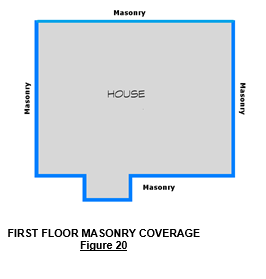
All openings in a structure such as windows and doors should relate to each other on all elevations both vertically and horizontally. This should occur in some clearly defined order, and scattered or random placements should be avoided. Both entrances and windows should be in proportion as they relate to the building mass as a whole. All sides of a home should receive equal design consideration. Reflective glass is prohibited.
Entrances should be the focal point of the elevation which they serve. Although two-story entryways are allowed, the creation of a focal point at the entry through the use of human scaled entry elements is suggested. Recessed or protruded one-story elements add to the architectural detail of the home. Regardless of the scale selected, entrances should always relate to the overall architectural character and quality of the home. Siding is not allowed in the front entry.
Windows, like entrances, should be compatible with the overall building mass and architectural character and quality of the elevation.
If shutters are incorporated as part of the design, they should be appropriately scaled to relate to the window opening and appear authentic. They .must also always occur in pairs. The shutter color must harmonize with the other colors on the home. Where shutters are used on a home located on a corner lot, they should occur on the side street elevation as well as the front.
Windows on the front elevation (first and second floors) must be consistent with the design of the elevation of the homes. Windows on other elevations may be divided lite or single pane, bronze or white bronze.
25-year warranty, three-dimensional composition asphalt shingles. All shingles within a given neighborhood shall be the same color.
If chimneys protrude from an elevation and are located on the front elevation, the side-street side elevation of a corner lot or the rear elevation on a lake, or greenbelt lot, the chimney must be brick, stone or stucco, in conformance with the architecture. Prefabricated metal flues should be clad in approved materials to create the image of a traditional masonry chimney. The use of wood or fiber-cement siding is not allowed.
If a chimney is interior to the roof (not on an external elevation) or at the rear or non-corner side of a home, it must be constructed of materials that match the architectural style and color of the home. Acceptable materials include masonry, brick, stucco, wood or fiber-cement siding.
Spark arrestors and caps are required on all chimneys. The spark arrestor and cap should be unadorned, non-ornamental and designed to match or be compatible with the color and material of the exterior elevations of the home. Caps must be of metal or masonry construction.
Heights of chimneys shall meet all fire code requirements and be proportional to the roofline of the respective home. Metal chimneys, if used, shall not exceed a maximum exposed height of six inches (6") of chimney pipe nor a maximum height of eighteen inches (18") of total exposed metal including both chimney pipe and cap.
Garage doors should be relatively unadorned while remaining compatible with the architecture of the home and elevations. Panel doors are encouraged to help downscale the effect of a garage door.
The address number must be visible from the street. The scale of the address number may vary according to the scale of the home, but may be no larger than 6 inches (6") in height and must be placed in a horizontal line. The street name is not permitted on the exterior of the home.
The specific style and font shall be as approved by the ARC and the numbers must be easily read from the street.
The number for address identification should be inset into the brick either next to the front door or on the front of the home. Internally-lit address numbers are not permitted.
The type, color, and quality of exterior lighting for the site and home must be consistent with other lighting on the property and in the neighborhood. Incandescent lighting is preferred. However, the ARC recognizes that new lamps and bulbs are available and will review alternative types. No high-wattage, commercial/industrial-type fixtures, mercury vapor, or sodium-vapor light sources are allowed in any location.
Floodlighting fixtures must be attached to the home or other architectural structure and must not illuminate adjacent public or private properties. Lights must be directed downward and shielded to avoid "hot" glare spot visible by neighbors. Fixture and shield color should be compatible with the building. Conduits and wiring must be concealed.
All exterior light fixtures visible from the street or other public areas must be of an understated design that complements the architectural style of the residence.
Walkway lighting should be an inconspicuous bollard or dome light design. The lamp may be incandescent (100w maximum), quartz (75w maximum), metal halide (75w maximum), fluorescent (25w maximum), or white L.E.D.
Fences, walls and landscaping are acceptable screening materials. All wood fences must be constructed in accordance with these Builder Guidelines.
On corner lots, side-lot A/C compressors and/or home generators must be enclosed behind the side lot fence. On interior lots, A/C compressors and/or home generators may be enclosed in the side lot fence or screened from public view by landscape materials.
Color variety among homes is required. The ARC shall determine whether near or adjacent homes' brick or trim colors are too similar to allow. No more than three colors (plus brick or stone color) shall be permitted. Trim color and field color must vary.
Exterior paints and stains shall complement colors of other materials. Siding and trim should generally stay within the earthtone color family. White and cream trim is permitted. Extremely bold or primary colors are prohibited. Bright yellow, blue, or green pastels are not allowed. Soft, muted earthtone pastel colors are acceptable.
Acceptable brick colors are in the earthtone color family. Very dark colored brick is discouraged. No one brick color should dominate a particular street scene. Variety in brick color is strongly encouraged. A brick color may be repeated every fifth home including same and opposite side of street.
Stone Veneer shall be natural limestone or manufactured stone of similar color other regional stone color deemed appropriate with the project character as approved by the ARC.
No security devices such as sirens and speaker boxes shall be visible from a public view and should be located inside the home. Security devices should be the minimum effective size and be located unobtrusively. These Builder Guidelines also prohibit security and/or burglar bars on the exterior of homes unless specifically approved by the ARC prior to installation.
"Structured Residential Wiring" is a centralized method of organizing and distributing coaxial cabling, data and security wiring from a central distribution point for flexibility, accessibility and future expansion for each home.
Second story balconies will be allowed on the back of the homes when the back of lot faces greenbelts, ditches, detention basins, amenity areas, or major thoroughfares.
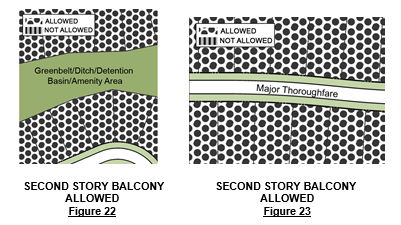
Second story balconies will not be allowed when the back of lot faces another lot.
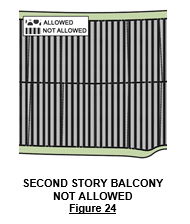
Second story balconies will not be allowed when the back of lot faces another lot and a greenbelt, ditch, detention basin, amenity area or major thoroughfare.
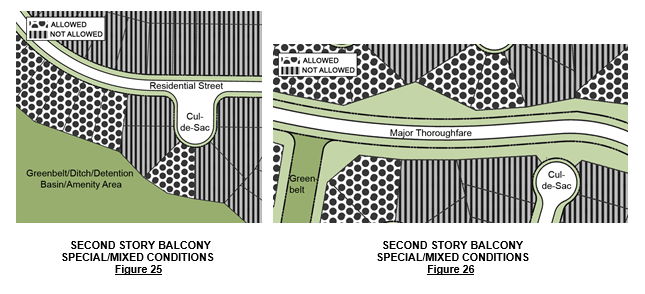
A concrete patio that has an exposed foundation that is greater than one foot (1') in height should be covered with masonry which matches, or is complimentary to the masonry of the residence.
Unless otherwise approved by the ARC, there shall be no individual mailboxes located at each residence, but rather, all mailboxes shall be cluster-type mailboxes at locations approved by the ARC and which shall comply with all federal, state, and local laws, rules, and regulations.
Realizing that model homes will function as sales offices, modifications to the finished product that would actually be sold is expected. However, Builders are expected to emulate as closely as possible the end product that a consumer can expect to receive.
Before sale by the Builder, all modifications (e.g., front yard fencing, atrium doors in lieu of overhead garage doors, floodlights, etc.) must be removed and the unit restored to its standard appearance.
Each model should have, unless otherwise specified by the ARC, yard lights installed that will illuminate the model homes during the period from dusk to 10:00 p.m. The Builder may employ other types of illumination upon approval of the ARC.
Fencing on sales models will always be of an iron/metal material of a standard configuration where it is adjacent to front yards. Fences will always permit view of the home and into the lot from the street. Model home fences should never exceed four feet (4') in height in the front yard. Wood fencing is allowed in the rear yards of model homes. All fence designs must be submitted to the ARC for review and approval.
A maximum of one (1) flagpole per model home site, per builder will be allowed to display a U.S. flag, a Texas flag, or builder flag and must be properly lit.
The flagpole should be one-piece construction of brushed anodized aluminum not to exceed thirty-five feet (35') in height. The pole should be capable of withstanding local wind velocities.
The length of the flag should be approximately one-fourth (1/4) the height of the pole on which it is mounted. Building-mounted flagpoles are not permitted. Flags and/or poles must be replaced when they become faded or worn.
Exterior of model homes should be kept in a new and fresh condition. Doors, siding, and trim are to be kept clean and painted when necessary. If, in the opinion of the ARC, areas of a model home require refurbishing, the ARC will give the respective builder two (2) weeks notice in writing in which to correct the deficiencies.
The front and rear yards of all model homes are to be landscaped including fully sodded yards and foundation plant material. Front yard and street trees will be planted in accordance with previously promulgated rules of the ARC and these Guidelines. A minimum of one (1) rear yard tree is required. Model homes shall be allowed to install small water ponds, waterfalls, etc. which shall be removed at the time the model home is converted to a residential home.
One (1) yard sign per lot is allowed for the purpose of advertising a particular Builder name or to advertise the property. for sale or rent. No additional sign, advertisement, billboard, or advertising structure of any kind shall be displayed to public view on any lot.
Builders will be allowed one (1) yard sign per builder, per model park. The sign may be a maximum of thirty-two square feet (32-sq. ft.) in area. Base landscaping is required. The sign will be allowed for a period of time commensurate with the model homes sales program only. Model identification signs may not exceed three square feet.(3 -sq..ft..) In addition, one (1) sign no larger than three (3) square feet may be used to indicate whether a model home is open/closed and the hours of operation only. This sign must be close to the front door.
The ARC has the right to remove any sign, advertisement, billboard, or advertising structure which is in violation of these guidelines. All model home signage packages must be submitted to the ARC for review and approval.
End of Builder Guidelines